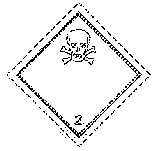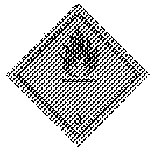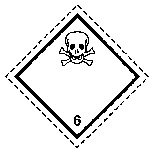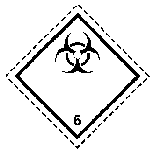| Non-flammable, non-toxic gas | A substance which—
(a) at 50°C has a vapour pressure greater than 300 kilopascals absolute or is completely gaseous at 20°C at a standard pressure of 101.3 kilopascals; and
(b) is carried at an absolute pressure of not less than 280 kilopascals or in liquefied form,
other than a toxic gas or a flammable gas.
| — | — | 2.2 |  | COMPRESSED GAS |
| Toxic gas | A substance which at 50°C has a vapour pressure greater than 300 kilopascals absolute or is completely gaseous at 20°C at a standard pressure of 101.3 kilopascals and which is toxic. | — | — | 2.3 |  | TOXIC GAS |
| Flammable gas | A substance which—
(a) at 50°C has a vapour pressure greater than 300 kilopascals absolute or is completely gaseous at 20°C at a standard pressure of 101.3 kilopascals and is flammable; or
(b) is packed in an aerosol dispenser where that dispenser contains either—
(i) more than 45 per cent by mass of a flammable substance, or
(ii) more than 250 grammes of a flammable substance,
and in this sub-paragraph flammable substance means a flammable gas or flammable liquid having a flash point less than or equal to 100°C.
| — | — | 2.1 |  | FLAMMABLE GAS |
| Flammable liquid | A liquid with a flash point—
(a) above 61°C and which is carried at a temperature above its flash point; or
(b) of 61°C or below except—
(i) a liquid which has a flash point equal to or more than 35°C, and when tested in accordance with the appropriate approved method does not support combustion,
(ii) a viscous substance which complies with the provisions of Part III and is contained in a receptacle with a capacity of less than 450 litres, or
(iii) a substance which is classified as a flammable gas because it has the hazardous properties specified in sub- paragraph (b) corresponding to the entry for a “flammable gas” in column 1.
| (a) (in the case of any liquid having a flash point of less than 23°C and containing either not more than 5% of toxic or corrosive substances with a packing group of I or II or not more than 5% of flammable liquids with a packing group of I and a subsidiary hazard of toxic or corrosive)—
(i) less than 3% of it separates out into a clear solvent layer following a suitable solvent separation test,
(ii) the flash point of it is specified in column 1 of the Table set out in Part IV,
(iii) the kinematic viscosity of it is within the range specified in column 2 of the Table set out in Part IV which is opposite to the flash point of that liquid referred to in head (ii), and
(iv) is contained in a receptacle with a capacity of less than 450 litres; or
(b) (in the case of any other liquid) it has—
| III | 3 |  | FLAMMABLE LIQUID |
(i) an initial boiling point not greater than 35°C,
| I |
(ii) an initial boiling point above 35°C and a flash point of less than 23°C, or
| II |
(iii) an initial boiling point above 35°C and a flash point of 23°C or above.
| III |
| Flammable solid | (a) a solid which, under conditions encountered in carriage, is readily combustible or may cause or contribute to fire through friction; or
(b) a self-reactive or related substance which is liable to undergo a strongly exothermic reaction; or
(c) a desensitised explosive where the explosive properties have been suppressed.
| A substance which is— | | 4.1 |  | FLAMMABLE SOLID |
(a) water-wetted and (when in a dry state) required to be classified (as defined by regulation 2(1) of the Classification and Labelling of Explosives Regulations (Northern Ireland) 1991) in pursuance of regulation 3(2)(a) of those Regulations;
| I |
(b) (i) substance; or a self-reactive
(ii) a readily combustible solid which, when ignited, burns very vigorously or intensely and is difficult to extinguish;
| II |
(c) a readily combustible solid which when ignited burns vigorously or intensely.
| III |
| Spontaneously combustible substance | A substance which is liable to spontaneous heating under conditions encountered in carriage or to heating in contact with air being then liable to catch fire. | A substance which is— | | 4.2 |  | SPONTANE- OUSLY COMBUSTIBLE |
(a) a pyrophoric substance which ignites instantly on contact with air;
| I |
(b) liable to ignite on contact with air within a short space of time, particularly under conditions of spillage; or
| II |
(c) any other substance which is liable to ignite on contact with air.
| III |
| Substance which in contact with water emits flammable gas | A substance which in contact with water is liable to become spontaneously combustible or to give off a flammable gas. | A substance which— | | 4.3 |  | DANGEROUS WHEN WET |
(a) either reacts vigorously with water at ambient temperatures and demonstrates generally a tendency for the gas produced to ignite spontaneously or reacts readily with water at ambient temperatures so that the rate of evolution of flammable
| I |
(b) reacts readily with water at ambient temperatures so that the maximum rate of evolution of flammable gas is equal to or greater than 20 litres per kilogramme of substance per hour; or
| II |
(c) reacts slowly with water at ambient temperatures so that the maximum rate of evolution of flammable gas is greater than 1 litre per kilogramme of substance per hour.
| III |
| Oxidising substance | A substance other than an organic peroxide which, although not necessarily combustible, may by yielding oxygen or by a similar process cause or contribute to the combustion of other material. | A solid substance which, when mixed with cellulose in a ratio of either 1:4 or 1:1 by mass, exhibits a burning rate at least as fast as that for a— | | 5.1 |  | OXIDIZING AGENT |
(a) 3:2 mixture by mass of potassium bromate and cellulose;
| I |
(b) 2:3 mixture by mass of potassium bromate and cellulose; or
| II |
(c) 3:7 mixture by mass of potassium bromate and cellulose.
| III |
| A liquid substance which, when mixed with cellulose in a ratio of 1:1 by mass, exhibits a pressure rise at least as fast as that of a 1:1 mixture by mass of— | |
(a) 50% perchloric acid and cellulose;
| I |
(b) 40% aqueous sodium chlorate solution and cellulose; or
| II |
(c) 65% aqueous nitric acid and cellulose.
| III |
| Organic peroxide | A substance which is—
(a) an organic peroxide; and
(b) an unstable substance which may undergo exothermic self- accelerating decomposition.
| Any substance classified as an organic peroxide. | II | 5.2 |  | ORGANIC PEROXIDE |
| Toxic substance | A substance which is liable either to cause death or serious injury or to harm human health if swallowed or inhaled or by skin contact. | A substance which has been allocated to— | | 6.1 |  | TOXIC |
(a) packing group I in accordance with the criteria set out in Part V;
| I |
(b) packing group II in accordance with the criteria set out in Part V; or
| II |
(c) packing group III in accordance with the criteria set out in Part V.
| III |
| Infectious substance | A substance which either contains viable micro- organisms that are known or reasonably believed to cause disease in animals or humans or genetically- modified micro-organisms and organisms which are infectious. | — | — | 6.2 |  | INFECTIOUS SUBSTANCE |
| Corrosive substance | A substance which by chemical action will—
(a) cause severe damage when in contact with living tissue; or
(b) materially damage freight or equipment if leakage occurs.
| A substance which— | | 8 |  | CORROSIVE |
(a) causes full thickness destruction of skin tissue at the site of contact within an observation period of 60 minutes starting after testing on the intact skin of an animal for a period of 3 minutes or less;
| I |
(b) causes full thickness destruction of skin tissue at the site of contact within an observation period of 14 days starting after testing on the intact skin of an animal for a period of more than 3 minutes but not more than 60 minutes;
| II |
(c) causes full thickness destruction of skin tissue at the site of contact within an observation period of 14 days starting after testing on the intact skin of an animal for a period of more than 60 minutes but not more than 4 hours; or
| III |
(d) causes corrosion in steel or aluminium surfaces at a rate exceeding 6.25 mm a year at a test temperature of 55°C.
| III |
| Miscellaneous dangerous goods | A substance which—
(a) is listed in the approved carriage list and which may create a risk to the health and safety of persons in the conditions encountered in carriage whether or not it has any of the hazardous properties of any other classification;
(b) contains a genetically- modified micro- organism which is capable of altering animals, plants or microbiological substances in a way which is not normally the result of natural reproduction but excluding any infectious substance; or
(c) is hazardous to the environment but excluding any substance which—
(i) is an explosive or radioactive material,
(ii) possesses any of the hazardous properties of any other classification, or
(iii) constitutes dangerous goods for any other reason.
| — | — | 9 |  | —” |